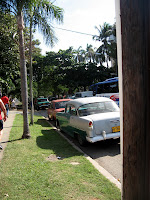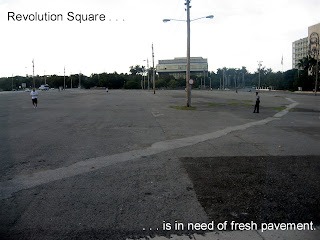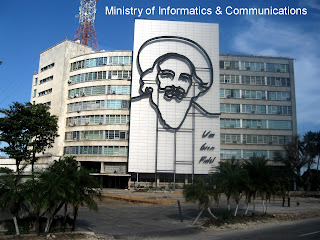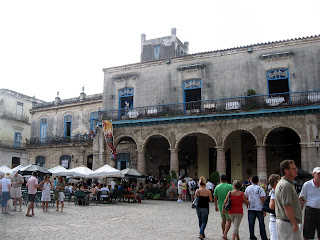Tuesday, January 26, 2010
The Road Home
Sunday, January 24, 2010
La Arcadia
Friday, January 22, 2010
Xanadu & Golf





Tuesday, January 19, 2010
Sakura


Sunday, January 17, 2010
Centro Habana










Tuesday, January 12, 2010
Vedado










Saturday, January 9, 2010
Habana Vieja

We emerged from the tunnel in the historic heart of
The walking tour with Tour Guide Tony would begin at Plaza de

As Tony led us to the square, I gazed around at the mix of old & new cars driving about, the docked cruise ship Europa, and a police officer holding a 12-guage shotgun. The square is small but bustling with activity ranging from workers restoring buildings to the 4 ‘harassments’ I just mentioned. After speaking for several minutes, we moved north, exploring the side streets. Old cannons and cannon balls are used as road barriers to prevent vehicles from traveling on certain roads. Many buildings in this area are finally being repaired after being neglected for decades due to lack of money. Being declared a heritage site by UNESCO has been a huge boost to the city.

Our tour group spent several minutes inside a secluded courtyard used as a restaurant, and cigar shop, where Tony talked more about cigars & which ones to buy. The tourists who’re more interested in site seeing waited patiently with frowns on their faces. Just before leaving, I snapped a picture of a camouflaged peacock that was sitting on some vines.

Next stop was the Plaza De Arma, a spacious square surrounded by Baroque buildings, filled with palm trees, and stocked with books. There are bookstands everywhere, making you feel like you’re in an outdoor Spanish Chapters store. In the centre of the plaza sits a large marble statue of Carlos Manuel, a Cuban planter who freed his slaves and made the declaration for Cuban Independence in 1868. The oldest military structure in


Tour Guide Tony led us two blocks west of the Plaza De Arms to the Hotel Ambos Mundos, located just across the former Ministry of Education. The hotel is famous for being the residence of American writer Ernest Hemingway during the early 20th century. A corner of the main lobby is dedicated to Hemingway, displaying many portraits of him living at the hotel. As explained by Tony, Hemingway drank mojitos in the morning, and dakaris in the afternoon. Tasty, but deadly on a regular basis. To honour the writer, we all ordered mojitos for 3 pesos at the lobby bar.

Just as my parents & I sat down to drink, we were interrupted by music from outside. I dashed out to check out the commotion and photographed a band accompanied with dancers on stilts marching up the street. It was quite a spectacle, watching the dancers chasing each other, and the band playing lively music. It looked like it had something to do with evil spirits.

Last stop before lunchtime was the Plaza de la Catedral. Here you find: the Baroque styled Catedral de

My parents & I got on the bus just in time, only to wait for another 25 minutes because a Chinese couple failed to show up. Tony had gone back to the place where he set us free but was unable to find them. The bus couldn’t wait any longer because we risked losing our reservations at the restaurant. As Victor drove the bus deeper into the city, everyone wondered how the missing couple would find us or get back to their hotel at the end of day.

To Be Continued . . .
Thursday, January 7, 2010
Road To Havana

The warm early morning greeted us as we waited at the front of the hotel to catch our bus after eating a well prepared breakfast buffet. My backpack carried my digital camera, pack of cards, book, sunscreen, bottled water, and toilet paper. Despite the successes of the revolution, it hasn’t been able to fully guarantee that all public washrooms will have available toilet paper . . . and toilet seats.

Following ‘Cuban Time’, our tour bus arrived 15 minutes late, carrying Canadian tourists from other hotels. The bus would later stop at a hotel in the town of
The drive to

As we drove through the bustling city of

The countryside highway was adequately maintained, snaking its way through lush green tropical countryside, art decoy houses, and under two concrete bridges that didn’t go anywhere. I was reminded by my travels in
The police checkpoint simply consisted of a small shack and radio tower, sitting on a rocky coastline, marking the border between the provinces of Matanzas & La Habana. The pit stop next to it consisted of a bar, restaurant, and small tourist shop. The assumptions I made while getting off the bus for the 20 minute break were correct: there were other tourist busses there, the pina coladas were good, there was a band playing next to the bar, and the washroom I used had no toilet seat or toilet paper (even though I didn’t need them).

As we neared

Sunday, January 3, 2010
Plaza America






